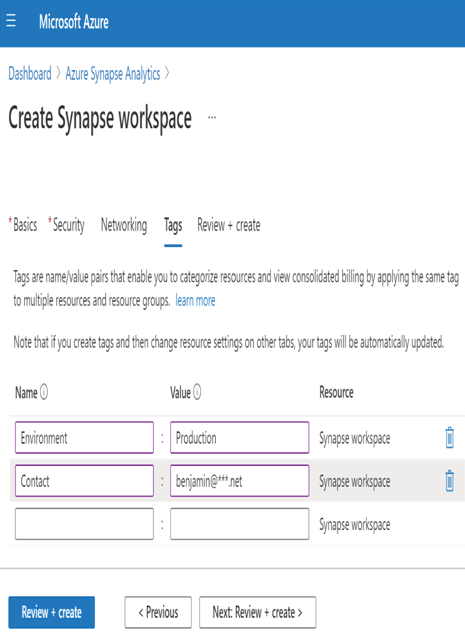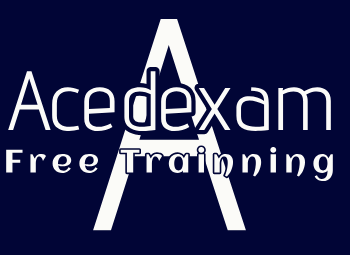Tags– Gaining the Azure Data Engineer Associate Certification

When you provision an Azure resource in the Azure portal, one common step is requesting tags (see Figure 1.30). This gives you the option to add a query‐able identifier to the resource. For example, you can mark it as production, test, or development, or perhaps identify a contact person for the given resource. Regardless, this is a valuable concept you might consider implementing to manage your Azure resources as your footprint grows.

FIGURE 1.30 Tags for Azure products
Azure DevOps
This product is based on application source code and the development process. A company’s application source code is stored in Azure Repos that store history. Azure Pipelines can be configured to automatically perform a release into production when source code is checked in. That process is commonly referred to as continuous integration/continuous deployment (CI/CD). Azure Boards and Azure Test plans are helpful in linking source code changes to specific work items and making sure the change works and meets the expectations of the requested work.
Summary
This chapter provided tips on preparing for the Data Engineering on Microsoft Azure exam. You learned about the importance of staying current and that you should make sure to work with Azure often, especially with Azure data service products. Working with these tools will keep the information fresh in your head and will make it much easier to pass the exam. Finally, this chapter introduced you to a large number of Azure products. Some of them you must know in great depth, whereas others you only need to know a little bit and the rest not so much. The point is that you know, or have at least some idea of, what most Azure products are and when you would use them.
Exam Essentials
Make sure you are on the right Azure path. There are numerous Azure certification paths. Make sure you are on the path that best fits your career’s objectives. Azure Data Engineer Associate certification is for data specialists who want to work with data warehouses, data lakes, Big Data, machine learning, and data intelligence gathering. Being curious is a very important trait of a data engineer, and looking for clues and trends in massive amounts of data should be a passion.
Gain experience with Azure. To pass this exam, you will need experience with the platform. Do not expect the book or training to get you through this without having worked on the platform for some amount of time. If you do that, then this certification will have greater meaning to you and others.
Keep up‐to‐date by subscripting to online resources. The Azure platform is constantly changing, which requires daily actions to keep your skills up‐to‐date. Here are some of the most popular resources to read on a regular basis.
https://docs.microsoft.com/azure
https://azure.microsoft.com/updates
https://azure.microsoft.com/services
https://docs.microsoft.com/azure/?product=analytics
Know what products exist in Azure. Sometimes, possible answers to exam questions mention products that are not real Azure products. They read or sound like they are, but they are not. Knowing what really is available on the platform will help you remove at least one possible answer to a few questions.
Gain deep, some and base knowledge. No one knows everything, but you can be an expert in one or two Azure products and features. Those products and features usually have a connection or dependency to other Azure features, which you could then learn some internals about. There are some products and features that are not related to any other directly. For example, there is no direct relationship between Azure Cognitive Services and a VNet. It would be good to have at least a base knowledge of what benefits they can provide.
Focus on certain products. The Azure Data Engineer Associate exam is heavy on Azure Synapse Analytics, SQL Pools, Azure Databricks, Azure Data Factory, Azure Active Directory, Azure Key Vault, and Stream Analytics products. Make sure you have a very good understanding of these products, their features, and their limits, as well as DataFrames, advanced SQL querying, clusters, and slowly changing dimensions (SCDs). This knowledge gives you the best chance of passing the exam.
When you provision an Azure resource in the Azure portal, one common step is requesting tags (see Figure 1.30). This gives you the option to add a query‐able identifier to the resource. For example, you can mark it as production, test, or development, or perhaps identify a contact person for the given resource. Regardless, this…

Archives
- August 2024
- July 2024
- June 2024
- May 2024
- April 2024
- March 2024
- February 2024
- January 2024
- December 2023
- November 2023
- October 2023
- September 2023
- July 2023
- May 2023
- April 2023
- March 2023
- February 2023
- January 2023
- December 2022
- November 2022
- October 2022
- September 2022
- May 2022
- April 2022
- February 2022
- January 2022
- December 2021
- October 2021
- September 2021
- August 2021
- June 2021
- May 2021
- April 2021
Contact US